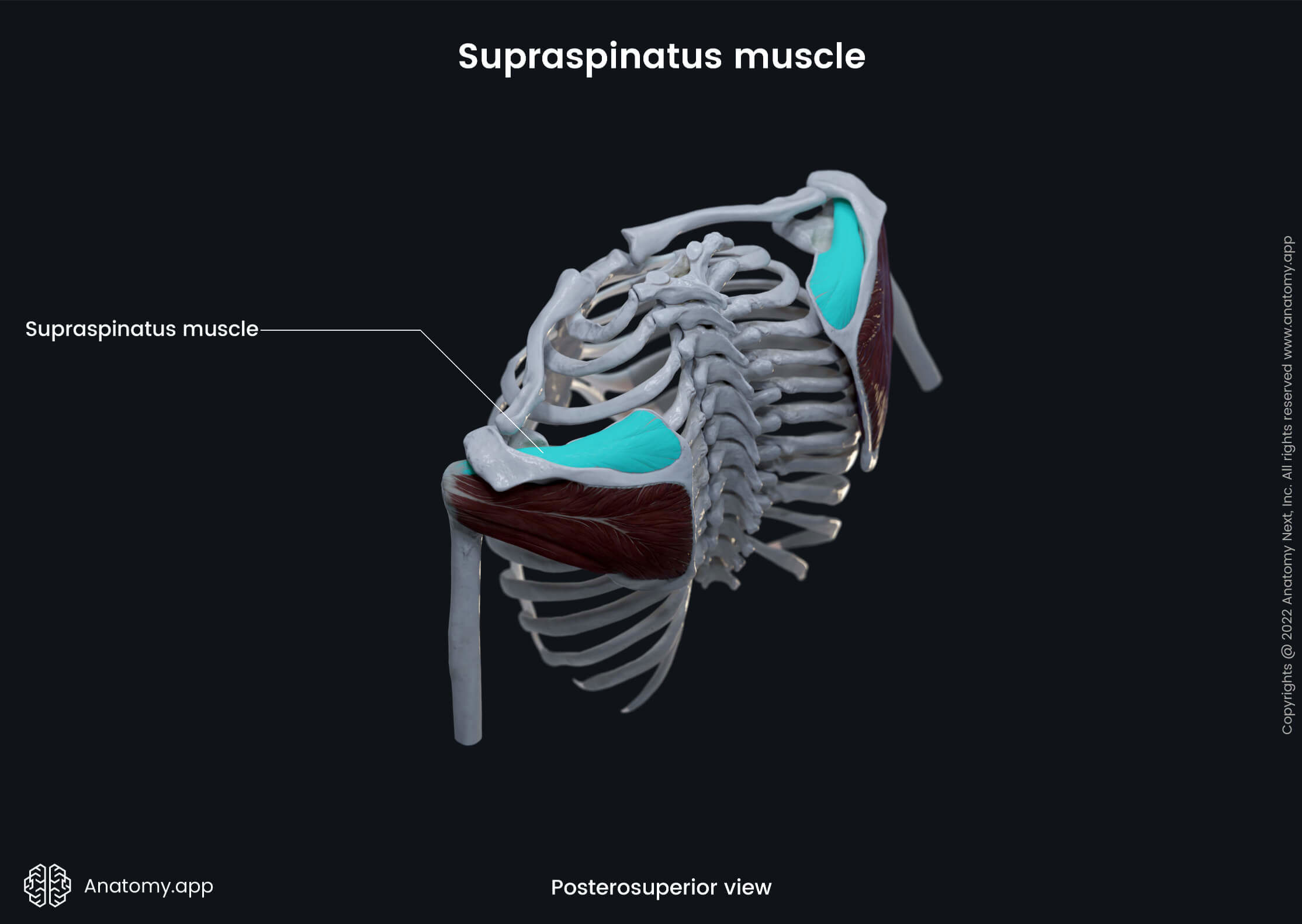- Anatomical terminology
- Skeletal system
- Joints
- Muscles
- Head muscles
- Neck muscles
- Muscles of upper limb
- Muscles of pectoral girdle
- Muscles of shoulder region
- Muscles of upper arm
- Muscles of forearm
- Muscles of hand
- Thoracic muscles
- Muscles of back
- Muscles of lower limb
- Heart
- Blood vessels
- Lymphatic system
- Nervous system
- Respiratory system
- Digestive system
- Urinary system
- Female reproductive system
- Male reproductive system
- Endocrine glands
- Eye
- Ear
Rotator cuff
The rotator cuff is a group of muscles located in the shoulder region of the upper limb. These muscles and their tendons stabilize and strengthen the shoulder joint and allow movements.
Four skeletal muscles connecting the scapula with the humerus form the rotator cuff, and these four muscles include the following:
As mentioned above, actions provided by the rotator cuff muscles happen at the shoulder or glenohumeral joint. Disorders affecting the rotator cuff muscles are often accompanied by pain. They interfere with the functions of the shoulder joint and cause the inability to perform movements. The most common disorder is rotator cuff tear.
Structure
The rotator cuff is a musculotendinous structure. All four rotator cuff muscles originate from the landmarks of the scapula, and their tendons insert on the greater or lesser tubercles of the proximal humerus.
The rotator cuff muscles transition into tendons near their attachment sites. These tendons blend into a confluent sheet before inserting on the humeral tubercles along with the shoulder joint capsule, coracohumeral and glenohumeral ligaments.

Function
The rotator cuff muscles provide a variety of movements at the shoulder joint. At the same time, this musculotendinous structure is essential in stabilizing the humeral head in the glenoid cavity of the scapula. The shoulder joint lacks bony stability, so it is primarily stabilized by both the static and dynamic soft tissue stabilizers.
The rotator cuff muscles help maintain a stable core at the shoulder joint around which the other shoulder girdle muscles can effectively act on the humerus. The rotator cuff muscles are responsible for the abduction, internal and external rotations and adduction of the arm. Overall, each rotator cuff muscle provides a different set of motions.
Rotator cuff muscles
Supraspinatus
The supraspinatus (Latin: musculus supraspinatus) is a triangular-shaped muscle that fills the supraspinous fossa of the scapula. It originates from the mentioned fossa and inserts on the greater tubercle of the proximal humerus. The supraspinatus tendon passes under the acromion, crosses over the glenohumeral joint and then inserts on the greater tubercle.

The main functions of this muscle are the abduction of the arm and shoulder joint stabilization. The innervation of the supraspinatus is provided by the suprascapular nerve (C5, C6). And finally, this muscle receives arterial blood supply from the suprascapular artery.
Infraspinatus
Like the supraspinatus, the infraspinatus (Latin: musculus infraspinatus) also originates from the posterior surface of the scapula, more precisely from the infraspinous fossa. And it also inserts on the greater tubercle of the humerus.

The infraspinatus stabilizes the shoulder joint and provides external rotation of the arm. Nerve supply is provided by the suprascapular nerve (C5, C6). The infraspinatus receives arterial blood supply from the suprascapular and circumflex scapular arteries.
Teres minor
The teres minor (Latin: musculus teres minor) is a rounded and narrow muscle that originates from the lateral margin of the scapula below the infraglenoid tubercle. It inserts on the greater tubercle of the proximal humerus.

Like other rotator cuff muscles, it stabilizes the shoulder. Besides that, the teres minor also provides external rotation of the arm. It is innervated by the axillary nerve (C5, C6), while the arterial blood supply is provided by the circumflex scapular and posterior circumflex humeral arteries.
Subscapularis
The subscapularis (Latin: musculus subscapularis) is a large triangular-shaped muscle that fills the subscapular fossa of the scapula. It originates from the mentioned fossa and inserts on the lesser tubercle of the proximal humerus. The subscapularis is the largest and strongest of the rotator cuff muscles.

The subscapularis provides internal rotation and adduction of the arm. Also, it stabilizes the shoulder joint. The subscapularis is innervation by the upper and lower subscapular nerves (C5 - C6). It receives arterial blood supply from the suprascapular and subscapular arteries.
Rotator cuff disorders
Rotator cuff disorders are a leading cause of shoulder pain and shoulder-related disabilities. These disorders usually are associated with age-related degenerative changes but might also be caused by trauma to the rotator cuff muscles. The most common injury affecting these muscles is rotator cuff tear, while other common disorders include rotator cuff tendinitis and tendinopathy. Rotator cuff tendinitis is an acute inflammation of the rotator cuff muscle tendon. In contrast, the therm rotator cuff tendinopathy usually refers to chronic inflammation or degenerative processes of the rotator cuff muscle tendon.
The rotator cuff tear is an injury to one or more rotator cuff muscle tendons. Due to the cause, the injured tendon is no longer fully attached to the structures of the humeral head. The most common tendon affected is the supraspinatus tendon. Rotator cuff tear usually presents with pain at rest and night and pain that increases with movements. Also, shoulder weakness when lifting or rotating the arm can be present. The rotator cuff tear can be caused by degenerative changes, repetitive microtraumas and severe acute injuries. Besides that, some other causes include atraumatic injuries, intrinsic (hypovascularity) and extrinsic factors (subacromial and internal impingement).
A comprehensive medical history, structured physical examination and imaging studies (X-ray) are often sufficient to diagnose rotator cuff injuries. Still, additional imaging tests (MRI or ultrasound) may be required to clarify the damage. The treatment for a rotator cuff tear includes rest, activity modification, physical therapy and exercises and medications that reduce pain and swelling. Sometimes, the rotator cuff tear requires surgery as a treatment method.